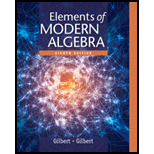
For
Want to see the full answer?
Check out a sample textbook solution
Chapter 8 Solutions
Elements Of Modern Algebra
- + Theorem: Let be a function from a topological space (X,T) on to a non-empty set y then is a quotient map iff vesy if f(B) is closed in X then & is >Y. ie Bclosed in bp closed in the quotient topology induced by f iff (B) is closed in x- التاريخ Acy الموضوع : Theorem:- IP & and I are topological space and fix sy is continuous او function and either open or closed then the topology Cony is the quatient topology p proof: Theorem: Lety have the quotient topology induced by map f of X onto y. The-x: then an arbirary map g:y 7 is continuous 7. iff gof: x > z is "g of continuous Continuous function farrow_forwardFor the problem below, what are the possible solutions for x? Select all that apply. 2 x²+8x +11 = 0 x2+8x+16 = (x+4)² = 5 1116arrow_forwardFor the problem below, what are the possible solutions for x? Select all that apply. x² + 12x - 62 = 0 x² + 12x + 36 = 62 + 36 (x+6)² = 98arrow_forward
- Select the polynomials below that can be solved using Completing the Square as written. 6m² +12m 8 = 0 Oh²-22x 7 x²+4x-10= 0 x² + 11x 11x 4 = 0arrow_forwardProve that the usual toplogy is firast countble or hot and second countble. ①let cofinte toplogy onx show that Sivast countble or hot and second firast. 3) let (x,d) be matricspace show that is first and second countble. 6 Show that Indiscret toplogy is firstand Second op countble or not.arrow_forwarda) Find the scalars p, q, r, s, k1, and k2. b) Is there a different linearly independent eigenvector associated to either k1 or k2? If yes,find it. If no, briefly explain.arrow_forward
- This box plot represents the score out of 90 received by students on a driver's education exam. 75% of the students passed the exam. What is the minimum score needed to pass the exam? Submitting x and Whickers Graph Low 62, C 62 66 70 74 78 82 86 90 Driver's education exam score (out of 90)arrow_forwardHow many different rectangles can be made whose side lengths, in centimeters, are counting numbers and whose are is 1,159 square centimeters? Draw and label all possible rectangles.arrow_forwardCo Given show that Solution Take home Су-15 1994 +19 09/2 4 =a log суто - 1092 ж = a-1 2+1+8 AI | SHOT ON S4 INFINIX CAMERAarrow_forward
- a Question 7. If det d e f ghi V3 = 2. Find det -1 2 Question 8. Let A = 1 4 5 0 3 2. 1 Find adj (A) 2 Find det (A) 3 Find A-1 2g 2h 2i -e-f -d 273 2a 2b 2carrow_forwardQuestion 1. Solve the system - x1 x2 + 3x3 + 2x4 -x1 + x22x3 + x4 2x12x2+7x3+7x4 Question 2. Consider the system = 1 =-2 = 1 3x1 - x2 + ax3 = 1 x1 + 3x2 + 2x3 x12x2+2x3 = -b = 4 1 For what values of a, b will the system be inconsistent? 2 For what values of a, b will the system have only one solution? For what values of a, b will the saystem have infinitely many solutions?arrow_forwardQuestion 5. Let A, B, C ben x n-matrices, S is nonsigular. If A = S-1 BS, show that det (A) = det (B) Question 6. For what values of k is the matrix A = (2- k -1 -1 2) singular? karrow_forward
 Elements Of Modern AlgebraAlgebraISBN:9781285463230Author:Gilbert, Linda, JimmiePublisher:Cengage Learning,Algebra & Trigonometry with Analytic GeometryAlgebraISBN:9781133382119Author:SwokowskiPublisher:Cengage
Elements Of Modern AlgebraAlgebraISBN:9781285463230Author:Gilbert, Linda, JimmiePublisher:Cengage Learning,Algebra & Trigonometry with Analytic GeometryAlgebraISBN:9781133382119Author:SwokowskiPublisher:Cengage

